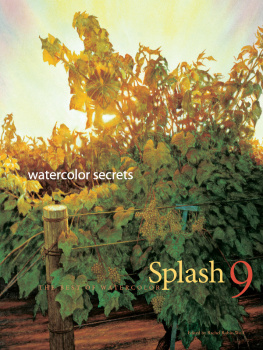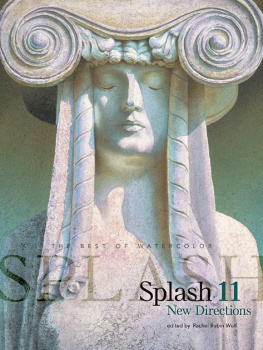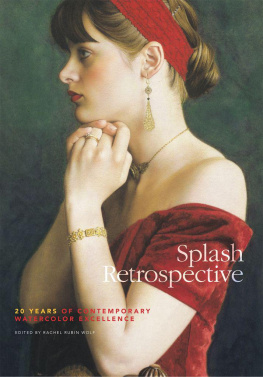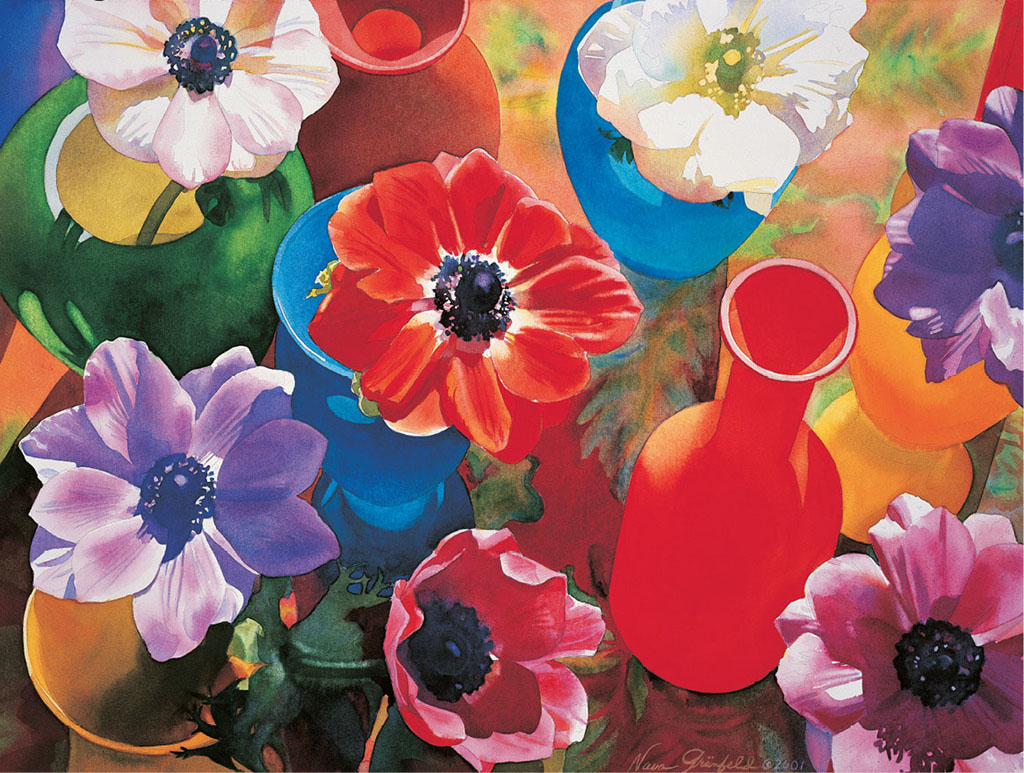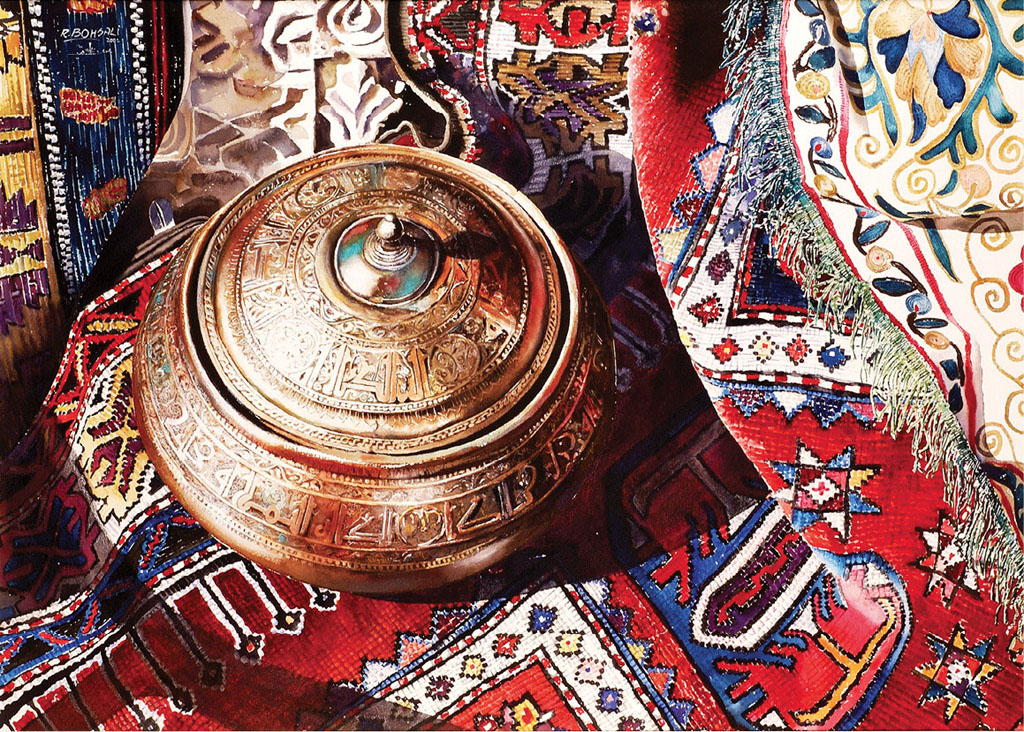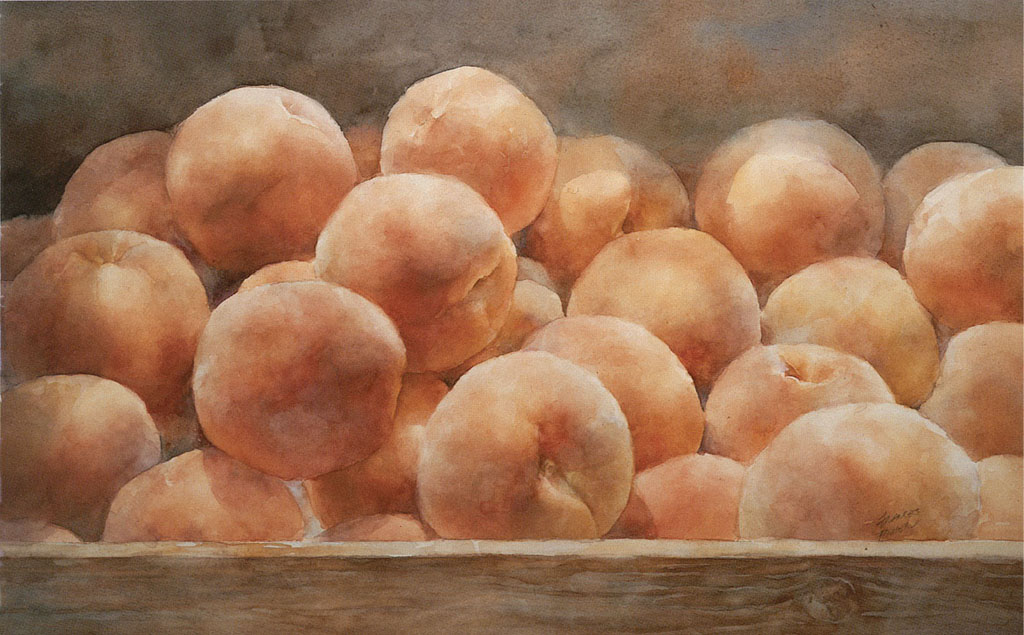Sign up for our newsletter and receive special offers, access to free content, and information on the latest new releases and must-have art resources! Plus, receive a coupon code to use on your first purchase from NorthLightShop.com for signing up.
RED VASE, NAVA GRUNFELD
Splash 8 p10, watercolor, 29" 41" (74cm 104cm)
Working on a grand scale in watercolor has allowed me to take a medium that is sometimes considered fussy and weak and show it capable of making a bold statement. In recent years I have concentrated on adding high-intensity color, strong light and an unusual perspective to my paintings of everyday objects, figures and flowers. Each painting is layered with many veils of transparent color, which I discovered gives it an intense color-saturated luminosity. The paintings glow almost as though they are lit from behind like a stained glass window.
Anemones are my favorite flower. I have done many paintings of them and am always intrigued; no two are alike. I use a round brush and paint wet-into-wet in sections of the painting, such as the vase. Under the red of the vase is a layer of yellow, which is what gives it its warm glow.
Introduction
It had to happen! The Best of the Best of Watercolor. Working on Splash for so many years (since 1990!), I have viewed countless images of watercolors. A few have stuck in my mind. I have to wonder, What is it about these particular paintings that burned such strong images in my brain?
Certainly, judging artwork cannot be reduced to a mathematical theorem or scientific formula. Ones life experience, training and personal preferences cannot help but be factors in how any particular work of art impacts another person. Yet there are also some objective standards like good drawing, pleasing composition, etc. Perhaps these, too, are personal preferences, at least in the priority we give them.
One attribute that counts a lot in my book is originality. Originality is another word for simply being true to oneself allowing ones inner voice to speak rather than adjusting ones voice for public acceptance. (This is a lot harder than it sounds!) For example, I see a lot of still lifes many good ones yet its fairly easy to pick those that stand out from the crowd. Elaborating on the quality of specialness is not quite as easy. Sure, there has to be a certain level of drawing skill and competence with the medium. But this is baseline. Many of the still lifes or flower paintings I see have a high level of technical mastery, yet feel uninspiring. What is it that makes a painting come alive?
Though a whole book could be written on the subject, I think one important element is the artists passionate involvement with the subject. We are talking still lifes here, not people, though the same holds true for portraits, landscapes or any subjects. When the artist is trying merely to produce something accurate, it will often fall short. Even still life (nature morte in French = dead nature) can come alive with the desire of the artist to bring something to the viewer. Painting is a polite way to say to everyone who passes by, Look at this! Isnt it amazing! One can be blown away by color, light, humor, subject matter, juxtaposition of objects, transparency, texture you name it! But whatever it is that makes the artists heart sing (or cry) is what should be communicated to the viewer. It can be as simple as Wow! Elephants are huge! Or Those peaches are so soft and fuzzy! Or maybe That cow looks like a puzzled old man!
It was truly difficult to select most of the artwork for this book. There are literally hundreds of terrific images from the first thirteen volumes of Splash. I relied mainly on my intuition and the inner Wow that came up automatically when re-viewing art I hadnt seen in a while. These are each very different from each other, both in subject and in style, yet each produces in me a strongly involved reaction that makes me want to linger at, almost enter into, the painting. These are the ones that have occupied some of my neurons for all these years.
As we, the Splash community, continue to share our love for watercolor and beauty, I hope you find this collection inspiring.
Rachel Rubin Wolf
BRIDGE OF SIGHS, LYNN HOSEGOOD
Splash 12 p83, watercolor on paper, 28" 19" (71cm 48cm)
NIGHT OF THE GYPSIES, FRED CHILTON
Splash 10 p47, watercolor on 140-lb. (300gsm) cold-pressed paper, 16" 24" (41cm 61cm)
TILLY, MARIANNE HUNT
Splash 7 p17, watercolor, 15" 11" (38cm 28cm)
CHAPTER 1
Still Life
ORIENTAL CHARM, RACHED K. BOHSALI
Splash 12 p118, transparent watercolor on Arches Aquarelle (Perrigot) paper, 30" 42" (76cm 107cm)
While setting up the composition of this painting, I was listening to Rimsky-Korsakovs Sheherazade. This pure coincidence made me unconsciously create a simple still life from two Caucasian rugs, a Persian Suzani and an antique brass pot from Baghdad. A friend said that he sensed in it the spicy fragrances of the warm and exotic old souls of the East Oriental Charm?
Rachels reflection
The selection of items and combinations of textures in this rich still life are not just impeccably executed, they conjure up images and aromas of something exotic and lovely. This is the story behind the painting.
JUST PEACHES, FRANCES MILLER
Splash 2 p117, watercolor, 19" 25" (48cm 64cm)
The number-one block to creativity is fear. Many artists are hesitant about trying new directions because of the fear of failure. I have managed to overcome this by using brainstorming, learned in a psychology of creativity class I took. The procedure is:
1. Preparation period during which you identify a problem to be solved.
2. Period of concentrated effort when you imagine answers, even obvious and absurd answers, playfully and freely.
3. Period of incubation during which you withdraw from the problem.


